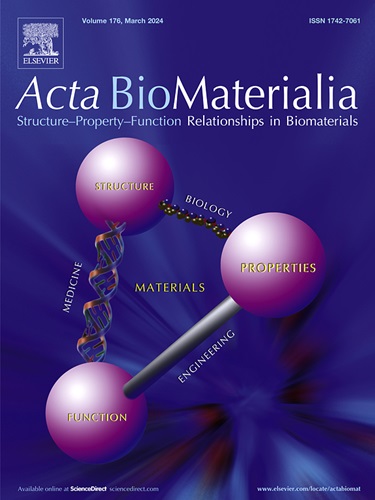巨噬细胞膜伪装纯药物纳米药物协同化疗和间质光动力治疗胶质母细胞瘤。
IF 9.4
1区 医学
Q1 ENGINEERING, BIOMEDICAL
引用次数: 0
摘要
胶质母细胞瘤(GBM)一直是一种高度致命的恶性肿瘤,目前的临床治疗显示多年来进展甚微。间质性光动力疗法(iPDT)因其微创性和低毒性而具有前景,但由于光敏剂渗透性差和GBM靶向性不足而受到阻碍。在这里,我们开发了一种仿生纯药物纳米药物(MM@CT),它将光敏剂氯e6 (Ce6)和一线化疗药物(替莫唑胺,TMZ)共同组装在一起,然后用巨噬细胞膜伪装。该设计消除了对传统辅料的需求,确保了配方的安全性,并实现了极高的载药量(73.2%)。通过利用巨噬细胞膜的仿生特性,MM@CT可以避开单核吞噬细胞系统的清除,并且由于其固有的肿瘤归巢能力,可以克服血液循环障碍靶向颅内GBM肿瘤。因此,这种靶向策略能够将TMZ精确递送到肿瘤部位,同时显著增强肿瘤组织内Ce6的积累。在肿瘤内使用光纤照射后,活化的Ce6与TMZ协同作用,发挥化疗的细胞毒作用和iPDT的独特优势,以双重方式同时攻击GBM肿瘤。在皮下和颅内GBM小鼠模型中,MM@CT表现出显著的抗肿瘤功效,且全身毒性最小,是一种很有前景的GBM治疗策略。意义声明:胶质母细胞瘤(GBM)仍然是一种可怕的脑癌,由于血脑屏障(BBB)的存在和肿瘤的异质性,给治疗带来了重大挑战。为了克服这些障碍,我们开发了MM@CT,一种具有73.2%的载药效率的仿生纳米药物。MM@CT包含光敏剂Ce6和化疗剂TMZ,包裹在纳米颗粒内,用巨噬细胞膜伪装。这种创新的设计能够有效地穿透血脑屏障,精确地靶向肿瘤,并协同应用化疗和光动力治疗。令人鼓舞的是,临床前评估显示出实质性的抗肿瘤活性和最小的全身毒性,将MM@CT定位为GBM的有希望的治疗策略。本文章由计算机程序翻译,如有差异,请以英文原文为准。

Macrophage membrane-camouflaged pure-drug nanomedicine for synergistic chemo- and interstitial photodynamic therapy against glioblastoma
Glioblastoma (GBM) persists as a highly fatal malignancy, with current clinical treatments showing minimal progress over years. Interstitial photodynamic therapy (iPDT) holds promise due to its minimally invasive nature and low toxicity but is impeded by poor photosensitizer penetration and inadequate GBM targeting. Here, we developed a biomimetic pure-drug nanomedicine (MM@CT), which co-assembles the photosensitizer chlorin e6 (Ce6) and the first-line chemotherapeutic drug (temozolomide, TMZ) for GBM, then camouflaged with macrophage membranes. This design eliminates the need for traditional excipients, ensuring formulation safety and achieving exceptionally high drug loading with 73.2 %. By leveraging the biomimetic properties of macrophage membranes, MM@CT evades clearance by the mononuclear phagocyte system and can overcome blood circulatory barriers to target intracranial GBM tumors due to its inherent tumor-homing ability. Consequently, this targeted strategy enables precise delivery of TMZ to the tumor site while significantly enhancing Ce6 accumulation within the tumor tissue. Upon intra-tumoral irradiation using an optical fiber, activated Ce6 synergizes with TMZ to exert both cytotoxic effects from chemotherapy and unique advantages from iPDT simultaneously attacking GBM tumors in a dual manner. In subcutaneous and intracranial GBM mouse models, MM@CT exhibits remarkable anti-tumor efficacy with minimal systemic toxicity, emerging as a promising GBM treatment strategy.
Statement of significance
Glioblastoma (GBM) remains a formidable brain cancer, posing significant therapeutic challenges due to the presence of the blood-brain barrier (BBB) and tumor heterogeneity. To overcome these obstacles, we have developed MM@CT, a biomimetic nanomedicine with exceptional drug loading efficiency of 73.2 %. MM@CT incorporates the photosensitizer Ce6 and chemotherapy agent TMZ, encapsulated within nanoparticles and camouflaged with macrophage membranes. This innovative design enables efficient BBB penetration, precise tumor targeting, and synergistic application of chemotherapy and photodynamic therapy. Encouragingly, preclinical evaluations have demonstrated substantial antitumor activity with minimal systemic toxicity, positioning MM@CT as a promising therapeutic strategy for GBM.
求助全文
通过发布文献求助,成功后即可免费获取论文全文。
去求助
来源期刊

Acta Biomaterialia
工程技术-材料科学:生物材料
CiteScore
16.80
自引率
3.10%
发文量
776
审稿时长
30 days
期刊介绍:
Acta Biomaterialia is a monthly peer-reviewed scientific journal published by Elsevier. The journal was established in January 2005. The editor-in-chief is W.R. Wagner (University of Pittsburgh). The journal covers research in biomaterials science, including the interrelationship of biomaterial structure and function from macroscale to nanoscale. Topical coverage includes biomedical and biocompatible materials.
 求助内容:
求助内容: 应助结果提醒方式:
应助结果提醒方式:


